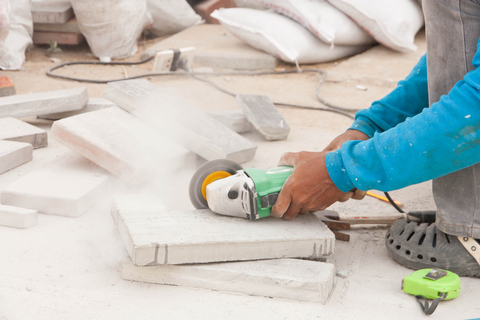
Crystalline Silica is one of the most recent workplace hazards rearing its ugly head. This material resides in large amounts within the earth’s crust. According to the Occupational Safety and Hazard Administration (OSHA) Quartz is the form of Crystalline Silica that presents the biggest issue in the workplace. Quartz has been linked to various lung diseases including lung cancer and silicosis, as well as kidney disease.
How does Silica effect the body?
In order for Quartz to administer its adverse effects it must enter the human body. The easiest way for this to occur is through respiration. Quartz is found in sand, stone, concrete, block, mortar, rock, and brick. Drilling, cutting, crushing, or sawing any of these materials releases fine Quartz particles into the air. These particles are small enough that they can be brought into the body through inhalation. OSHA estimates that 90% of the 2.3 million workers exposed every year are construction workers. Foundries, glass manufacturers, concrete industries, pottery industries, and hydraulic fracturing workers are also included in this statistic as they deal with large quantities of sand which makes them susceptible to the hazardous quartz particles. Although employers take measures to protect their workers, such as using water and venting systems, there must be further regulations instated in order to curb the danger to workers across the nation.
So what has been done to solve the problem?
OSHA has issued a new rule to combat the hazards presented by Crystalline Silica. OSHA projects that the new rule will save 600 lives every year, as well as prevent 900 new exposure cases per year. Additionally, the rule has the potential to provide net benefits of 7.7 billion dollars every year. Construction companies will be required to adhere to the new standards by June 23 of 2017. While General Industry and Hydraulic Fracturing Companies must comply by June 23 of 2018. This new OSHA rule contains multiple new components, as well as a few reforms to current policy.
First, the PEL, or Permissible Exposure Limit, is an air quality control measure that monitors the level of Crystalline Silica in the workplace. OSHA’s new rule will lower the PEL, meaning that a lower level of Silica will be required to continue working in the measured area for every 8 hour shift. Employers will have to work to ensure the Crystalline Silica levels stay below the new PEL.
Secondly, Employers will be required to provide engineering controls to maintain low Silica levels (Water or Ventilation). If engineering controls are not available then Employers are obligated to provide respirators. Employers will also be required to limit access to high exposure areas, offer medical exams, and inform employees on the dangers of Silica.
These regulations will reduce the number of exposure cases every year, as well as save lives over the long term. OSHA has taken a huge step in protecting workers across the nation. Construction workers, General Industry employees, and Hydraulic Fracturing laborers, by 2018, will have crystal clear safety.
Please see our followup article discussing the backlash resulting from the new regulation.




